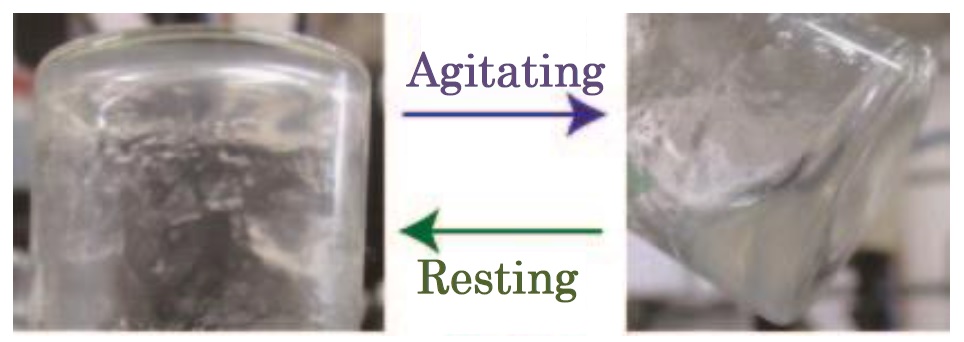Development of Free-Moldable Electrolyte
December 21, 2016
Assistant Professor Kazuhiro Shikinaka and Associate Professor Yoichi Tominaga (Division of Applied Chemistry, Institute of Engineering, Tokyo University of Agriculture and Technology) developed gel consisting of ionic liquid and cylindrical clay mineral. This gel is novel electrolyte with high ionic conductivity that shows liquid/solid transition in response to agitating/resting. The obtained result gives free-moldable solid electrolyte that is expected for application for energy/electronics fields. This work was supported by the JSPS KAKENHI Grant Number 26870179 and 16H04199. This research was published on 12th December 2016 in the Chemical Communications.
Electrolytes are fundamental materials that have been used in various industrial fields, for example, in batteries. Liquid electrolytes, though widely used, lack safety and moldability because of the inclusion of organic solvents and the inherent fluidity. The superior safety and moldability of solid electrolytes make them possible alternatives to liquid electrolytes. However, the ionic conductivity of solid electrolytes is lower than that of liquid electrolytes. Recently, a gel-type electrolyte, which combines the high ionic conductivity of liquid electrolytes and the safety of solid electrolytes, has been reported. However, the gel-type electrolyte needs various specific techniques for molding.
Dr. Shikinaka and Tominaga reported a novel "quasi-solid electrolyte" comprising a transparent thixotropic gel swelled by an ionic liquid. The thixotropic gel is formed by a framework of single-walled aluminosilicate cylindrical inorganic “imogolite” (IG) nanotubes. Synthetic IG purified by reprecipitation from tetrahydrofuran disperses into hydrophilic and polar ionic liquid phases. The mixture of an ionic liquid and short-length IG shows ionic conductivity, similar to the neat ionic liquid. The formation of a network of short IG units in the ionic liquid by interaction with the dicarboxylic acid units affords gel-like quasi-solid electrolytes. These electrolytes show thixotropy, and their viscoelasticity depends on the ionic liquid species. The quasi-solid electrolyte shows moldability, thermal stability, high ionic conductivity, and has potential applications in free-moldable conductive and anti-icing coatings, or electrolytes for batteries.

Paper
| Authors | K. Shikinaka, N. Taki, K. Kaneda, and Y. Tominaga |
|---|---|
| Title | Quasi-Solid Electrolyte: Thixotropic Gel of Imogolite and Ionic Liquid |
| Journal | Chemical Communications |
| DOI | 10.1039/C6CC07765J |
| URL | http://pubs.rsc.org/en/content/articlehtml/2017/cc/c6cc07765j |
Acknowledgment
This work was supported by JSPS KAKENHI Grant Number 26870179,16H04199.
Related Information
TUAT research factors (English): http://www.rd.tuat.ac.jp/en/activities/factors/index.html
Researcher information (English):
Kazuhiro Shikinaka
Yoichi Tominaga
Pressrelease (Japanese): 自由成形が可能な電解質素材の開発に成功 (PDF:199KB)
Contact
Kazuhiro Shikinaka, Assistant Professor, Division of Applied Chemistry, Institute of Engineering,
Tokyo University of Agriculture and Technology
+81-42-388-7406
